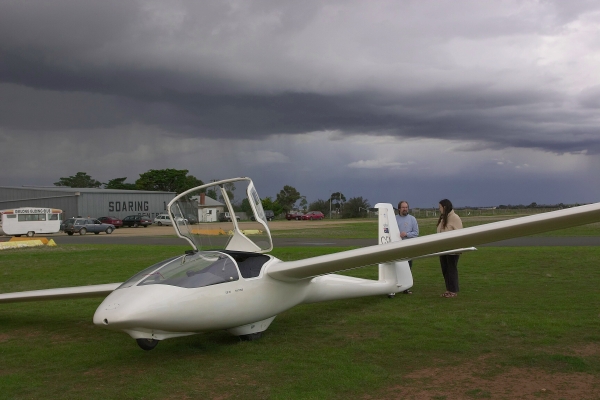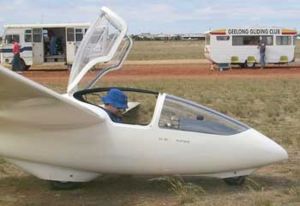PlaneSpottingWorld welcomes all new members! Please gives your ideas at the Terminal.
Schneider ES-65
| The Platypus prototype at Geelong Gliding Club, Australia. | |
| Type designation | ES-65 |
| Competition class | Two seater |
| Crew | 2 |
| Length | 7.7 m |
| Height | 1.7 m |
| Cockpit width | 1.20 m |
| Cockpit height | 0.95 m |
| Wingspan | 17.73 m |
| Wing area | 15.8 m² |
| Aspect ratio | 19.3 |
| Wing profiles | FX 61-184 (root), FX 60-126 (tip) |
| Empty mass | 400 kg |
| Water ballast | N/A |
| Maximum mass | 590 kg |
| Wing loading | 36.4 kg/m² |
| Maximum speed | 260 km/h (140 kts) |
| Speed in strong turbulence | 185 km/h (100 kts) |
| Stall speed | 72 km/h (39 kts) |
| Minimum sink rate | ca. m/s |
| Best glide ratio | ca. 38 |
The Schneider ES-65 Platypus is a two-seater unflapped glider designed and built by Edmund Schneider Ltd in Australia. A single prototype was built.
History
With the advent of the fibreglass designs onto the Australian scene during the mid 1960's the Australian manufacturer Edmund Schneider Ltd., began to look at a replacement for the very successful ES52 Kookaburra trainer. This resulted in the development of the ES63; a 17 metre span high performance two seater of advanced concept. A lack of capital combined with a difference of opinion with the GFA Design and Development Committee resulted in the project being shelved. In 1982 Harry Schneider revived the concept incorporating some design changes and improvements to bring the project up to date. This resulted in a prototype; the ES65 Platypus, being built and first flown on 2nd August 1984. The aircraft was universally accepted by those who flew it as an excellent design, of exceptional performance, and with the advantages for training engendered with the side by side seating arrangement. Unfortunately the venture capital to finance the glider's production has not been forthcoming.
General Description
The prototype is of wood/glass construction. The prototype's two piece wing is of 17 metre span, with a beech spar, birch ply skin covered by GFRP (the production wing was to be of GFRP construction). Seating is side by side arrangement in a most spacious cockpit. The two piece canopy with the aft section being rear hinged has ample visibility through large areas of perspex to the point of being able to see the rudder during flight. Rudder pedals and seats are adjustable allowing good accommodation for pilots of any size for long flights, with or without parachutes. The tail is mounted low on the fin with both rudder and elevator having horn balances smoothly blended into the design. There are three wheels on the centre line of the fuselage and, on entering the cockpit, the nose drops comfortably onto the forward wheel. This has made a reasonable balance about the main wheel possible, making the tail quite light to lift during on-ground manhandling.
Performance is typical of an advanced fibreglass machines. The aircraft is fairly sensitive in pitch, picking up speed rapidly on lowering the nose. Thermalling requires a speed of around 50 knots, while exhibiting good stability in circling allowing for relaxed handling while thermalling. Rate of roll from 45° bank to 45° is excellent at 4.5 secs. The Platypus spins well, with a smooth slowish turn, not very steep from which recovery is precise and rapid with standard spin recovery procedures. The performance seems to be good for instructing cross-country flights over long distances. The side by side seating causes some initial confusion with horizon perception in turns, but the advantages are for the instructor in assessing the student, and the ability to communicate and demonstrate.
The prototype, VH-GFA, is owned by a syndicate of members of the Victorian Motorless Flight Group (V.M.F.G.)[1] based at Bacchus Marsh airfield, Victoria.

Sources
- Geelong Gliding Club website
- Simons M, Segelflugzeuge 1965-2000, Eqip, 2004

